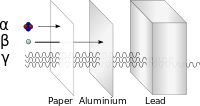
Photo from wikipedia
Abstract Pure LaAlO 3 and LaAl 1-x Ni x O 3 samples (x = 0.05, 0.1, 0.15, 0.2, 0.25, 0.3) were prepared using a sol-gel technique. The samples were analyzed and characterized… Click to show full abstract
Abstract Pure LaAlO 3 and LaAl 1-x Ni x O 3 samples (x = 0.05, 0.1, 0.15, 0.2, 0.25, 0.3) were prepared using a sol-gel technique. The samples were analyzed and characterized using XRD, SEM, FT-IR and XPS. The results showed that the infrared emissivity of LaAl 1-x Ni x O 3 powder prepared at 1500 ℃ for 2 h increases with Ni 2+ doping content. For x = 0.25, the mean emissivity in the 3–5 µm infrared spectral region was 0.835. This was a 142% increase compared with that of pure LaAlO 3 (0.345). The doped Ni ions mainly exist with valences of + 2 and + 3 in the LaAlO 3 lattice. After doping, the concentration of electron holes and oxygen vacancies increased, leading to an enhancement of free carrier absorption in the system. It indicated that the Ni 2+ doping would introduce an impurity energy level in the forbidden band of LaAlO 3 by first principles calculation, forming primarily by the hybridization of the 3d orbital electrons of the Ni ions and the 2p orbital electrons of the oxygen atoms. When x = 0.25, the band gap decreased from 3.50 eV to 0.77 eV. The impurity energy level allows for a reduction in the energy required for the electrons transferring from the valence band to the conduction band, causing increased numbers of electron transitions between the band gaps, thus enhancing free carrier absorption and increasing the infrared emissivity of the material. The LaAl 1-x Ni x O 3 oxide materials prepared in this work had excellent infrared radiation properties. As a lining material at high temperature reacting furnace, the energy loss could be reduced, the heat utilization efficiency would be greatly improved, and the utility model could be used in the field of high-temperature thermal energy saving.
Journal Title: Ceramics International
Year Published: 2018
Link to full text (if available)
Share on Social Media: Sign Up to like & get
recommendations!